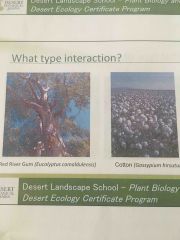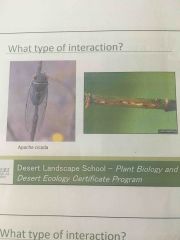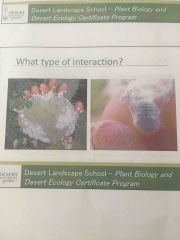![]()
![]()
![]()
Use LEFT and RIGHT arrow keys to navigate between flashcards;
Use UP and DOWN arrow keys to flip the card;
H to show hint;
A reads text to speech;
45 Cards in this Set
- Front
- Back
- 3rd side (hint)
|
Ecology |
The study of organisms in terms of their relationship with their environment. |
All together |
|
|
Plant Biology |
The study of plants, sometimes referred to as Botany |
|
|
|
Biome |
A geographic ecosystem characterized by distinctive vegetation that has developed under specific climatic conditions |
Tundra, Desert |
|
|
Arid |
Dry environment characterized in a desert biome |
|
|
|
Airflow |
Global air movement |
|
|
|
Airflow |
Global air movement |
|
|
|
30* N and S |
Most desert environments exist near this latitude |
|
|
|
Airflow |
Global air movement |
|
|
|
30* N and S |
Most desert environments exist near this latitude |
|
|
|
The interior effect |
As air moves over a landmass, it loses moisture in the form of rain. Without passing over another large body of water the air becomes a drier and drier.
Many deserts form in the interior of continents |
Outside in |
|
|
Airflow |
Global air movement |
|
|
|
30* N and S |
Most desert environments exist near this latitude |
|
|
|
The interior effect |
As air moves over a landmass, it loses moisture in the form of rain. Without passing over another large body of water the air becomes a drier and drier.
Many deserts form in the interior of continents |
Outside in |
|
|
The rain shadow effect |
Moist air is blowing toward a mountain range from an area near water, as air is forced to rise, it cools and drops rain on the Windward side, the dry air heats up as it descends causing intense evaporation on Leeward side. |
Sierra Nevada mountains |
|
|
North American desert regions |
Great Basin Mojave Sonoran Chihuahuan |
|
|
|
Community |
Groups of species interacting together at the same place at the same time Example: all biotic components in the desert oasis pond |
|
|
|
Habitat |
The area or natural environments in which an organism or community normally lives
A habitat is made up of abiotic factors such as moisture, range of temperature, and availability of light, as well as biotic factors such as the availability of food in the presence of predators |
|
|
|
Habitat |
The area or natural environments in which an organism or community normally lives
A habitat is made up of abiotic factors such as moisture, range of temperature, and availability of light, as well as biotic factors such as the availability of food in the presence of predators |
|
|
|
Abiotic |
Non-living Examples: Water Soil Availability of light Mechanical Temperature |
|
|
|
Species |
A group of organisms that are similar because they are descended from a common ancestor and can interbreed |
|
|
|
Species |
A group of organisms that are similar because they are descended from a common ancestor and can interbreed |
|
|
|
Evolution |
Process by which species gradually accumulate differences from their ancestors |
|
|
|
Evolutionary mechanisms |
Natural selection Artificial selection Chance events Mutation |
|
|
|
Adaptation |
Adaptations are outcomes of evolutionary change. Characteristics that allow an organism to live successfully in their environment.
Physiological: nocturnal, underground living
Structural: spines, camouflage |
|
|
|
Natural selection |
Individual organisms with particular characteristics tend to survive and reproduce at a higher rate than other individuals because of those particular characteristics
Example: Birds like green beetles more than orange, so the orange beetle tends to survive and mate |
|
|
|
Artificial Selection |
Intentional breeding for certain desirable traits or combination of traits
Example: Modern produce Pesticide resistant corn |
|
|
|
Organism |
Individual example of a species |
|
|
|
Symbiosis |
Organisms interact with the other organisms within their habitat in a variety of ways. These interactions can be fleeting or long-lasting and can have both positive or negative implications |
|
|
|
4 types of symbiosis |
Mutualism Commensalism Predation Competition |
|
|
|
Mutualism |
Any relationship between individual organisms of different species and we're both individuals benefit |
++ |
|
|
Mutualism |
Any relationship between individual organisms of different species and we're both individuals benefit |
++ |
|
|
Commensalism |
Describe the relationship between two living organisms where one benefits and the other is not significantly harmed or helped |
+0 |
|
|
Predation |
Herbivory: An interaction where any animal consumes a plant. It is the flow of energy through organisms by which one organism gains energy by consuming another organism.
Parasitism: an interaction where one organism uses another organism as a host to provide energy, shelter, or a place to grow and reproduce offspring. |
|
|
|
Predation |
Herbivory: An interaction where any animal consumes a plant. It is the flow of energy through organisms by which one organism gains energy by consuming another organism.
Parasitism: an interaction where one organism uses another organism as a host to provide energy, shelter, or a place to grow and reproduce offspring. |
|
|
|
Competition |
A relationship between organisms competing for resources such as food, water, space, shelter, mate, ecological status, etc., where both organisms are taxed. This often occurs when resources become scarce. |
|
|

|
Parasitism (or in some cases commensalism) |
|
|

|
Mutualism |
|
|

Front (Term) |
Competition |
|
|

Front (Term) |
Parasitism |
|
|

Front (Term) |
Parasitism (or in most cases commensalism) |
|
|
|
Mycorrhizae |
The relationship between specific fungi and plants that increase the amount of root surface for greater intake of water and nutrients while the plant provides food for the fungi. |
|
|
|
Biotic |
Living organisms |
|
|
|
List 3 characteristics that describe a desert biome |
Limited water High rate of evaporation Temperature extremes |
|
|
|
Describe the main physiological and structural plant adaptations found in a desert biome |
Physiological: Night blooming Leaf production Rain roots
Structural: Camouflage Water storage in leaves Leaf color |
|
|
|
Describe symbiosis and give examples. |
Mutualism: pollinators ++ Commensalism: cactus wren nests +o Predation: Parasitism, doves eating fruit +- Competition: Eucalyptus and cotton -- |
|

